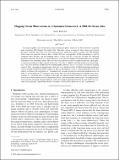Mapping Ocean Observations in a Dynamical Framework: A 2004-06 Ocean Atlas
Author(s)
Forget, Gael
DownloadForget-2010-Mapping Ocean Observ.pdf (5.938Mb)
PUBLISHER_POLICY
Publisher Policy
Article is made available in accordance with the publisher's policy and may be subject to US copyright law. Please refer to the publisher's site for terms of use.
Terms of use
Metadata
Show full item recordAbstract
This paper exploits a new observational atlas for the near-global ocean for the best-observed 3-yr period from December 2003 through November 2006. The atlas consists of mapped observations and derived quantities. Together they form a full representation of the ocean state and its seasonal cycle. The mapped observations are primarily altimeter data, satellite SST, and Argo profiles. GCM interpolation is used to synthesize these datasets, and the resulting atlas is a fairly close fit to each one of them. For observed quantities especially, the atlas is a practical means to evaluate free-running GCM simulations and to put field experiments into a broader context. The atlas-derived quantities include the middepth dynamic topography, as well as ocean fluxes of heat and salt–freshwater. The atlas is publicly available online (www.ecco-group.org). This paper provides insight into two oceanographic problems that are the subject of vigorous ongoing research. First, regarding ocean circulation estimates, it can be inferred that the RMS uncertainty in modern surface dynamic topography (SDT) estimates is only on the order of 3.5 cm at scales beyond 300 km. In that context, it is found that assumptions of “reference-level” dynamic topography may yield significant errors (of order 2.2 cm or more) in SDT estimates using in situ data. Second, in the perspective of mode water investigations, it is estimated that ocean fluxes (advection plus mixing) largely contribute to the seasonal fluctuation in heat content and freshwater/salt content. Hence, representing the seasonal cycle as a simple interplay of air–sea flux and ocean storage would not yield a meaningful approximation. For the salt–freshwater seasonal cycle especially, contributions from ocean fluxes usually exceed direct air–sea flux contributions.
Date issued
2010-06Department
Massachusetts Institute of Technology. Department of Earth, Atmospheric, and Planetary SciencesJournal
Journal of Physical Oceanography
Publisher
American Meteorological Society
Citation
Forget, Gaël. “Mapping Ocean Observations in a Dynamical Framework: A 2004–06 Ocean Atlas.” Journal of Physical Oceanography 40.6 (2010) : 1201-1221. Copyright c2010 American Meteorological Society
Version: Final published version
ISSN
0022-3670
1520-0485